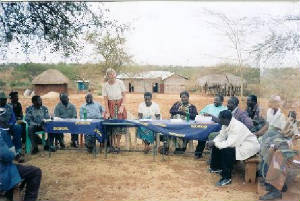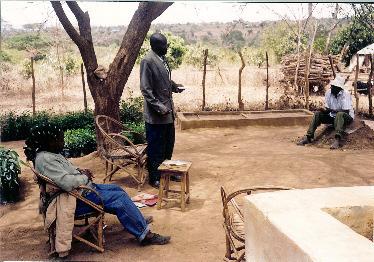KVDC is becoming a model for community
participation in development. The community has taken full
leadership since theinitiation of the project and women play an active role. This
picture shows the Chairlady confidently highlighting the achievements to the visitors during the DANIDA site tour in September
2004. In her remarks the Chairlady,
Ms Milka Mwaka, returned gratitude
to Kilisa community for their support and
to DANIDA for their financial and technical in-put and acknowledged continued support from the government officials. The Chairlady
reported of having spent all the allocated funds and in accordance to the plans. “This would not have been achieved
without the support of the community” she remarked. She thanked the Government for their continued recognition of the
project and their support in seconding a teacher to the adult education program. She further indicated that, a KVDC community
member had also volunteered to assist as a teacher in the adult education program.

A-forestation:
One of the major concerns in the village is severe de-forestation
and the associated lack of wood for construction and energy.De-forestation has turned Kilisa village into a brown dusty and
unproductive village as a result of erosion among other factors. Search for firewood is increasingly taking more time today
than in the past.In response, KVDC is committed to tree planting which will give the village a new look. The members of the
committee who were trained on tree planting have taken the initiative to educate the community on the need to plant and care
for the trees. They have trained others (including elders on tree planting).The community’s dream is to transform Kilisa
village from a brown, heavily eroded
and unproductive village (as
shown in the Map at the right end ) into one that is green, reasonably forested and productive (as shown in the Map below ).


Water harvesting:
According to the baseline study, lack of water is one of the
chronic problems in Kilisa village. This is a result of frequent droughts, severe de-forestation and uncontrolled sand harvesting
by communities upstream. The rivers are dry most of the year. One of KVDC’s developmental objectives is to ensure adequate
water supply through improved reservation of water beds and harvesting. In this regard, KVDC has started by de-silting the
only Dam in the village.The first clip of the picture above shows the dam before de-silting. The scene is that of severe deforestation
around the Dam. With that scanty vegetation silting is inevitable. The elders remember Kilisa Dam as an area surrounded by
thick grass and vegetation. At that time the dam held water through out the year. This is now history.KVDC is committed to
reconstruct the areas and reclaim the lost scenery. The process has started with the de-silting of the Dam through community
effort (contribution in labor as demonstrated in the second clip in the picture above) and grant from Church mission. The
grant supported hire for a tractor. Through joint effort, the Dam de-silting was completed timely in September 2004, in good
time for the rains.On the right, Villagers stand at the deepest point next to the flow pipe.This project gives hope to this child in the picture who at adulthood may enjoy
a better environment than his parents if this dam will be protected from de-silting.The Dam is a great help to the elders whose tree nursery is by the Before de-silting
Community at work at the dam After de-silting dam. The proximity will save them time and energy spent on drawing water from
a distance source. As another approach to water harvesting, KVDC has sunk a shallow well and installed a hand pump with the
assistance of SACDEF.The water is already being used for vegetable farming. The vegetables are sold to the community at a
subsidized price. KVDC is beginning to realize one of its objectives, promotion of good nutrition and ensuring food security
for their growth monitoring and feeding program. The project will, in addition,promote good nutrition in the greater community.This
project has been inspirational to others. For instance, a villager who has a farm next to the well has replicated this community
effort with very good results. A gain KVDC is realizing of its extended objective of stimulating individual effort.KVDC members
have been trained on the construction of wells and installation of hand pumps. This expertise will be available to private
individuals in Kilisa and the adjacent villages. KVDC, however, considers the expansion of well concept a short-term
strategy. Their long term plan is to build gabions along perennial rivers (Tawa , Uaani and Thwake) that form three quarters
of village borders as reflected in the map of “Kilisa in the future” above. Gabions will form subsurface dams, surface water reservoirs. These subsurface water reservoirs will ensure
adequate water for the surrounding vegetation and also for large-scale irrigation along the rivers. Already KVDC is piloting
this. With the support of partners in development KVDC has made a small dam in Tawa River and are now pumping water to the
development site. This will accelerate development of the site-based activities.In addition, the gabions will hold lots of
sand. Sand can be another source of income. Unlike the practice elsewhere, sand harvesting by KVDC will be controlled in-order
to avoid the adverse effects of sand harvesting that has astated the environment in other parts of Machakos and Makueni district.
KVDC suspect there is underground water that needs to be tapped. This will require technical expertise and equipment e.g.
a grid. KVDC seeks partner in the expansion of this concept. This is seen as a great opportunity for income generation, such
a grid could service adjacent communities at a subsidized fee.KVDC has developed a proposal on the concept on the Gabions construction and some of the
members of the community have been trained on gabion construction. Interested partners are invited to join the community
in this effort.

|
| Before de-Silting-------------------------Community at Work------------------------ After de-Silting |
Micro-financing:
KVDC considers micro financing as one of the approaches for breaking
the circle of poverty in Kilisa, a village experiencing frequent drought and poor food production. Very
often villagers are ill prepared for
the
next rain season. Some do not have the means to plough their farms and many do not have enough seeds
let alone the right mixes of seeds. This situation is a major factor in maintaining vicious cycle of
poverty in the village.KVDC envisions a time when late preparation
of farm and lack of seek will not be contributing factors to poverty in Kilisa village.To translate their vision into action, KVDC has started micro
financing to support the needy. Although on a small scale at the moment, the initiative exposes
the committee to the basic principles of micro financing and the associated challenges.In this picture an elderly lady receives her loan in the presence of the local administrator,
the Chief. KVDC encourages the involvement and presence of Government during the selection and eventual
award of the loan.KVDC plans to expand on this initiative if their search
for more support meets their expectation. In this regard, KVDC invites assistance
from development partners.
Technical
support:
The growth of KVDC has been
fast in terms of partners and activities. As a result the committee is increasingly in need managerial
and technical support. In this regard, consultations are at an advanced stage to have a US Peace Corps volunteer posted to Kilisa Project site to provide
the desired technical baking to the community. This support will enhance KVDC capacity to develop proposal,
market the proposals, implement, disseminate their best practices and write reports to their development
partners. African Economic Foundation (AEF) recognizes KVDC’s
efforts and the relevance to their mission and is therefore committed to assist KVDC achieve their goals.
In the long term AEF wishes to assist KVDC develop into a demonstration site and a resource center for
community based interventions in Kiteta location, Kisau division and Makueni district at large. With
more support KVDC could one time be a Rural Development Research Center
(RDRC), center of excellence and training for grass-root
initiatives.
Join AEF
effort ---Singularly or collectively. Together we can help KVDC make a difference in development
at the grass root level. It is at the grass root level where we ca make the greatest effort.